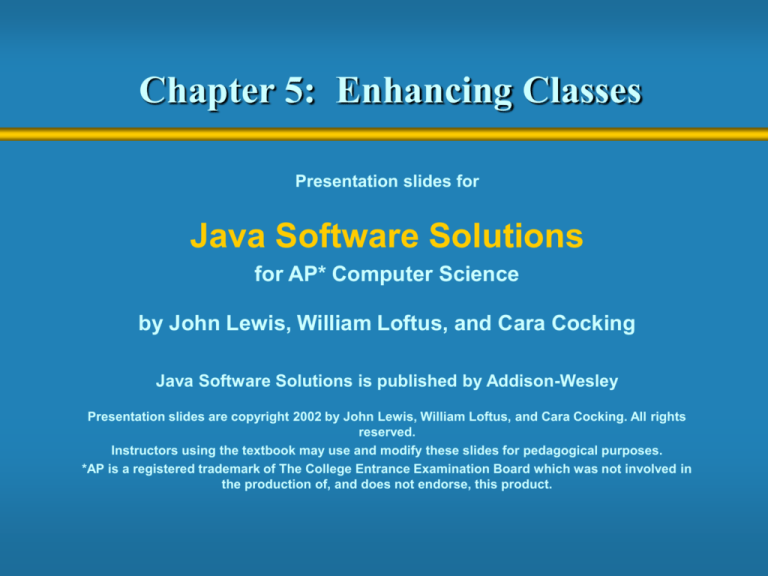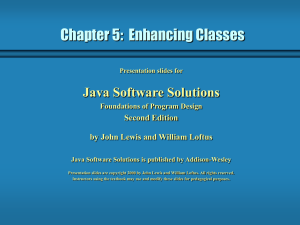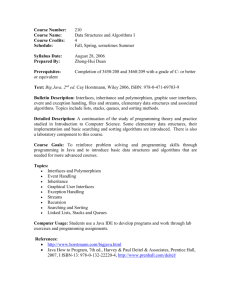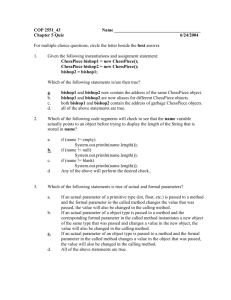
Chapter 5: Enhancing Classes
Presentation slides for
Java Software Solutions
for AP* Computer Science
by John Lewis, William Loftus, and Cara Cocking
Java Software Solutions is published by Addison-Wesley
Presentation slides are copyright 2002 by John Lewis, William Loftus, and Cara Cocking. All rights
reserved.
Instructors using the textbook may use and modify these slides for pedagogical purposes.
*AP is a registered trademark of The College Entrance Examination Board which was not involved in
the production of, and does not endorse, this product.
Enhancing Classes
Now we can explore various aspects of classes and
objects in more detail
Chapter 5 focuses on:
•
•
•
•
•
•
•
•
object references and aliases
passing objects references as parameters
the static modifier
exceptions
interfaces
nested classes and inner classes
dialog boxes
GUI components, events, and listeners
2
References
Recall from Chapter 2 that an object reference
variable holds the memory address of an object
Rather than dealing with arbitrary addresses, we
often depict a reference graphically as a “pointer” to
an object
ChessPiece bishop1 = new ChessPiece();
bishop1
3
The null Reference
An object reference variable that does not currently
point to an object is called a null reference
The reserved word null can be used to explicitly set
a null reference:
name = null;
or to check to see if a reference is currently null:
if (name == null)
System.out.println ("Invalid");
4
The null Reference
An object reference variable declared at the class
level (an instance variable) is automatically initialized
to null
The programmer must carefully ensure that an object
reference variable refers to a valid object before it is
used
Attempting to follow a null reference causes a
NullPointerException to be thrown
Usually a compiler will check to see if a local variable
is being used without being initialized
5
The this Reference
The this reference allows an object to refer to itself
That is, the this reference, used inside a method,
refers to the object through which the method is
being executed
Suppose the this reference is used in a method
called tryMe
If tryMe is invoked as follows, the this reference
refers to obj1:
obj1.tryMe();
But in this case, the this reference refers to obj2:
obj2.tryMe();
6
Assignment Revisited
The act of assignment takes a copy of a value and
stores it in a variable
For primitive types:
num2 = num1;
Before
After
num1
num2
num1
num2
5
12
5
5
7
Reference Assignment
For object references, assignment copies the
memory location:
bishop2 = bishop1;
Before
bishop1
bishop2
After
bishop1
bishop2
8
Aliases
Two or more references that refer to the same object
are called aliases of each other
One object (and its data) can be accessed using
different reference variables
Aliases can be useful, but should be managed
carefully
Changing the object’s state (its variables) through
one reference changes it for all of its aliases
9
Testing Objects for Equality
The == operator compares object references for
equality, returning true if the references are aliases
of each other
bishop1 == bishop2
A method called equals is defined for all objects, but
unless we redefine it when we write a class, it has the
same semantics as the == operator
bishop1.equals(bishop2)
We can redefine the equals method to return true
under whatever conditions we think are appropriate
10
Objects as Parameters
Parameters in a Java method are passed by value
This means that a copy of the actual parameter (the
value passed in) is stored into the formal parameter
(in the method header)
Passing parameters is therefore similar to an
assignment statement
When an object is passed to a method, the actual
parameter and the formal parameter become aliases
of each other
11
Passing Objects to Methods
What you do with a parameter inside a method may
or may not have a permanent effect (outside the
method)
See ParameterPassing.java (page 253)
See ParameterTester.java (page 254)
See Num.java (page 255)
Note the difference between changing the reference
and changing the object that the reference points to
12
The static Modifier
In Chapter 2 we discussed static methods (also called
class methods) that can be invoked through the class
name rather than through a particular object
For example, the methods of the Math class are static:
Math.sqrt (25)
To write a static method, we apply the static modifier
to the method definition
The static modifier can be applied to variables as well
It associates a variable or method with the class rather
than with an object
13
Static Variables
Static variables are also called class variables
Normally, each object has its own data space, but if a
variable is declared as static, only one copy of the
variable exists
private static float price;
Memory space for a static variable is created when
the class in which it is declared is loaded
All objects created from the class share static
variables
The most common use of static variables is for
constants
14
Static Methods
class Helper
public static int triple (int num)
{
int result;
result = num * 3;
return result;
}
Because it is static, the method can be invoked as:
value = Helper.triple (5);
15
Static Methods
The order of the modifiers can be interchanged, but
by convention visibility modifiers come first
Recall that the main method is static; it is invoked by
the system without creating an object
Static methods cannot reference instance variables,
because instance variables don't exist until an object
exists
However, a static method can reference static
variables or local variables
16
The static Modifier
Static methods and static variables often work
together
See CountInstances.java (page 259)
See Slogan.java (page 260)
17
Exceptions
An exception is an object that describes an unusual
or erroneous situation
Exceptions are thrown by a program, and may be
caught and handled by another part of the program
A program can be separated into a normal execution
flow and an exception execution flow
An error is also represented as an object in Java, but
usually represents a unrecoverable situation and
should not be caught
18
Exception Handling
Java has a predefined set of exceptions and errors
that can occur during execution
A program can deal with an exception in one of three
ways:
• ignore it
• handle it where it occurs
• handle it an another place in the program
19
Exception Handling
If an exception is ignored by the program, the
program will terminate abnormally and produce an
appropriate message
The message includes a call stack trace that
indicates the line on which the exception occurred
The call stack trace also shows the method call trail
that lead to the attempted execution of the offending
line
See Zero.java (page 262)
20
The throw Statement
Exceptions are thrown using the throw statement
Usually a throw statement is nested inside an if
statement that evaluates the condition to see if the
exception should be thrown
The following statement throws a
NoSuchElementException:
throw new NoSuchElementException();
21
Interfaces
A Java interface is a collection of abstract methods
and constants
An abstract method is a method header without a
method body
An abstract method can be declared using the
modifier abstract, but because all methods in an
interface are abstract, usually it is left off
An interface is used to establish, as a formal
contract, a set of methods that a class will implement
22
Interfaces
interface is a reserved word
None of the methods in
an interface are given
a definition (body)
public interface Doable
{
public void doThis();
public int doThat();
public void doThis2 (double value, char ch);
public boolean doTheOther (int num);
}
A semicolon immediately
follows each method header
23
Interfaces
An interface cannot be instantiated
Methods in an interface have public visibility by
default
A class formally implements an interface by
• stating so in the class header
• providing implementations for each abstract method in the
interface
If a class asserts that it implements an interface, it
must define all methods in the interface
24
Interfaces
public class CanDo implements Doable
{
public void doThis ()
implements is a
{
reserved word
// whatever
}
public void doThat ()
{
// whatever
}
Each method listed
in Doable is
given a definition
// etc.
}
25
Interfaces
A class that implements an interface can implement
other methods as well
See Complexity.java (page 264)
See Question.java (page 265)
See MiniQuiz.java (page 266)
In addition to (or instead of) abstract methods, an
interface can contain constants
When a class implements an interface, it gains
access to all its constants
26
Interfaces
A class can implement multiple interfaces
The interfaces are listed in the implements clause
The class must implement all methods in all
interfaces listed in the header
class ManyThings implements interface1, interface2
{
// all methods of both interfaces
}
27
Interfaces
The Java standard class library contains many
helpful interfaces
The Comparable interface contains an abstract
method called compareTo, which is used to compare
two objects
The String class implements Comparable, giving us
the ability to put strings in lexicographic order
The List interface is implemented by classes that
represent an ordered collection of elements.
The Iterator interface contains methods that allow
the user to move easily through a collection of
objects
28
The Comparable Interface
The Comparable interface provides a common
mechanism for comparing one object to another
if (obj1.compareTo(obj2) < 0)
System.out.println (“obj1 is less than obj2”);
The result is negative is obj1 is less that obj2, 0 if
they are equal, and positive if obj1 is greater than
obj2
When a programmer writes a class that implements
the Comparable interface, it should follow this intent
It's up to the programmer to determine what makes
one object less than another
29
The List Interface
The List interface represents an ordered collection
of elements
The size method returns the number of elements in
the list
The add method adds an element to the list
The iterator and listIterator methods return
iterators of the elements in the list
30
Iterator and ListIterator Interfaces
The Iterator and ListIterator interfaces provide
a means of moving through a collection of objects,
one at a time
The hasNext method returns a boolean result (true if
there are items left to process)
The next method returns the next object in the
iteration
The remove method removes the object most
recently returned by the next method
The ListIterator interface has additional methods
(add and set) that insert or replace an element in the
list
31
Designing Classes
When designing a class, there are two pieces of
information to think about:
• State (how an object is represented)
• Behavior (what an object does)
The state becomes the instance variables of an
object
The behavior becomes the methods
When thinking about behavior, you should think
about how others might want to use the object
32
Nested Classes
In addition to containing data and methods, a class
can contain other classes
A class declared within another class is called a
nested class
Enclosing Class
Nested Class
33
Nested Classes
A nested class has access to the variables and
methods of the enclosing class, even if they are
declared private
In certain situations this makes the implementation
of the classes easier because they can share
information easily
Furthermore, the nested class can be protected by
the enclosing class from external use
This is a special relationship and should be used with
care
34
Nested Classes
A nested class produces a separate bytecode file
If a nested class called Inside is declared in an
outer class called Outside, two bytecode files are
produced:
Outside.class
Outside$Inside.class
Nested classes can be declared as static, in which
case they cannot refer to instance variables or
methods
35
Inner Classes
A nonstatic nested class is called an inner class
An inner class is associated with each instance of
the enclosing class
An instance of an inner class can exist only within an
instance of an enclosing class
36
Dialog Boxes
A dialog box is a graphical window that pops up on
top of any currently active window for the user
The Swing API contains a class called JOptionPane
that simplifies the creation and use of basic dialog
boxes
There are three categories of JOptionPane dialog
boxes
• A message dialog displays an output string
• An input dialog presents a prompt and a single input text
field
• A confirm dialog presents the user with a simple yes-or-no
question
See EvenOdd.java (page 278)
37
The EvenOdd Program
38
Graphical User Interfaces
A Graphical User Interface (GUI) is created with at
least three kinds of objects
• components
• events
• listeners
A GUI component defines a screen element to display
information or allow the user to interact with the
program
• buttons, text fields, labels, menus, etc.
A container is a special component that holds and
organizes other components
• dialog boxes, applets, frames, panels, etc.
39
Events
An event is an object that represents some activity to
which we may want to respond
For example, we may want our program to perform
some action when the following occurs:
•
•
•
•
•
•
the mouse is moved
a mouse button is clicked
the mouse is dragged
a graphical button is clicked
a keyboard key is pressed
a timer expires
Events often correspond to user actions, but not
always
40
Events and Listeners
The Java standard class library contains several
classes that represent typical events
Components, such as an applet or a graphical
button, generate (fire) an event when it occurs
Other objects, called listeners, wait for events to
occur
We can write listener objects to do whatever we want
when an event occurs
A listener object is often defined using an inner class
41
Events and Listeners
Event
Component
Listener
This object may
generate an event
This object waits for and
responds to an event
When an event occurs, the generator calls
the appropriate method of the listener,
passing an object that describes the event
42
Listener Interfaces
We can create a listener object by writing a class that
implements a particular listener interface
The Java standard class library contains several
interfaces that correspond to particular event
categories
For example, the MouseListener interface contains
methods that correspond to mouse events
After creating the listener, we add the listener to the
component that might generate the event to set up a
formal relationship between the generator and
listener
43
Creating GUIs
To create a program with a GUI:
• define and set up the components
• create listener objects
• set up the relationships between the listeners and the
components which generate events of interest
• define what happens in response to each event
A push button is a component that allows the user to
initiate an action with the press of the mouse button
• defined by the JButton class
• generates an action event
A label is a component that displays a line of text (or
an image, or both)
• defined by the JLabel class
44
Creating GUIs
The init method of an applet can be used to set up
the GUI and add each component to the applet
container
The Swing version of the Applet class is called
JApplet
In a JApplet, components are added to the applet's
content pane
The content pane is retrieved using the
getContentPane method
A JButton generates an action event
See PushCounter.java (page 281)
45
The PushCounter Program
46
Action Listeners
The interface corresponding to an action event is
called ActionListener, which defines only one
method, called actionPerformed
The ButtonListener inner class implements the
ActionListener interface in the PushButton
program
When the button is pushed, the JButton object
invokes the actionPerformed method, passing it an
ActionEvent
The listener method may or may not make use of the
event object passed to it
47
GUI Applications
A frame is a container component used for standalone GUI-based applications
A panel is a container, but unlike a frame, it cannot be
displayed on its own
• it must be added to another container
• it helps organize the components in a GUI
See Fahrenheit.java (page 285)
See FahrenheitGUI.java (page 286)
48
The Fahrenheit Program
49
Summary
Chapter 5 has focused on:
•
•
•
•
•
•
•
•
object references and aliases
passing objects references as parameters
the static modifier
exceptions
interfaces
nested classes and inner classes
dialog boxes
GUI components, events, and listeners
50








